Rawan Mahmoud
Dr. Licastro
Eng 256 OM 1S
11 February 2019
The Lutheran Immigration and Refugee Services (LIRS) work with refugees, migrants, and children to make sure that not only are they welcomed into their new communities throughout America, but to also ensure that they are protected, and have a safe transition into America. Their services and advocacy fall into four different categories: protection, stabilization, integration, and the long welcome. Protection provides them with access to legal and physical support and protection of human rights. Stabilization provides them with access to resources and information. Integration provides them with opportunities to engage in their new communities. The long welcome is a project that provides them with successful integration.
Audience:
According to Writer/Designer, an audience is the intended reader of a text (Arola, Sheppard & Ball, 2018). The intended primary audience for LIRS would be donors, migrants, refugees, and children. The secondary intended audience would be volunteers, human rights advocates, Lutherans, and refugees or migrants that are seeking loans. Donors would be their primary intended audience because their donate button happens to be one of the main buttons that stands out, all throughout their website. Since the donate button happens to be highlighted, anyone that comes across this website, the first thing that will capture their attention would be the donate button. Refugee’s, migrants, and children also happen to be the primary audience because this website was made for the sole reason to reach out to any migrants, refugees or children that may need help. This author also happens to be reaching out to volunteers, human rights advocates, Lutherans, and loan seekers. Next to the donate button also happens to be a “take action” category, which has volunteers and advocates listed within it and on the right top corner is where migrants and refugees can find the loan button. Lutherans would be drawn to this website because they would want to provide help or bring awareness to their fellow Lutherans. People are drawn to this website because if they are looking for ways to help migrants or refugees, the author knows that the website provides them with everything they need to help out.
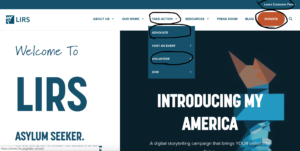
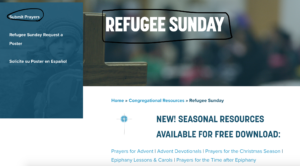
Purpose:
The purpose is the intention of the text. The Lutheran Immigration and Refugee Services purpose is to make sure that refugees, migrants, and children have all the resources that they may need in order for them to transition into their new lives as seamless as possible. LIRS’ purpose is to also ensure their safety and protection. They provide viewers with this information on their home page. Their home page also includes how many volunteers they happen to have and how many migrants and refugees they have welcomed into their care.

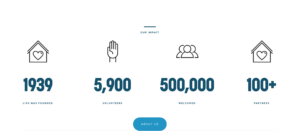
Context:
Writer/Designer describes context as “where the text is located, how it is meant to be read, or what surrounds it” (Arola, Sheppard & Ball, 2018). This medium is considered a website and the author most likely chose this as their medium because they wanted to inform and to reach out to as many people as they can. If the author had simply posted an ad in the newspaper or written a report about it, not everyone would have access to it. But because this information was posted online, almost everyone would have access to it. Someone can argue that not every migrant, refugee, or child has internet access but almost every library provides people with free access to the internet. This text is meant to be read virtually anywhere that has internet. It can be read on a computer or it can be read on a phone. Within the website, there are links news reports that surround the text. The news that is linked within the website discuss topics that are related to migrants, refugees, and children.

Author:
When it comes to a non-profit website, such as LIRS, the website tends to have more than one author because the role of running an organization like LIRS tends to be a lot for just one person. When it comes to websites, one of the first main thing that a person should do is to see if it is a credible source or not. Looking at the author will help determine if the source is credible or not. When it comes to the author/s for this website, the website itself provides a list of who is exactly on the board and the committee.
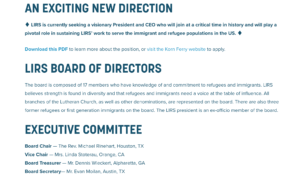
Genre:
According to Writer/Designer, genre is to, “help us recognize how to group similar texts and understand their communicative purpose” (Arola, Sheppard & Ball, 2018). For this website, it is clear that the website is a non-profit website because all of the donations that they receive goes directly to the migrants, refugees, and children. This website also happens to be an informative yet religious website. The website provides information on who the organization is, who the leaders are, how someone can help, and much more. They also happen to be a religious website because they have several sources on their website that discusses religious events that they can attend.
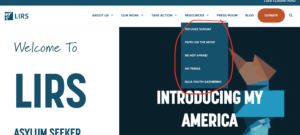 Modes of Communication:
Modes of Communication:
Throughout the website, there are multiple forms of linguistic modes, which happens to refer to the use of language.

The website provides multiple different linguistic modes, one of them being about information on how they can volunteer and help out.
With visual mode, the website has plenty of visual all throughout. The website includes various of different pictures and it even features a video. The color scheme of the website is generally the same, which is blue, white, and an orange almost red color. I believe that the author purposely made the donate button orange because it’s the color that stands out the most. It makes the reader’s eyes go straight to the donate button.
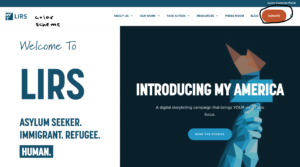
With aural mode, which focuses on sound. The website provides the viewer with two different videos that they can view. One of the videos discusses immigration detention, which is “the process of detaining non-citizens in prison-like settings while their immigration case is processed” (LIRS). The other video, which also happens to feature the CEO of LIRS, discusses refugees, migrants, and children and the reasons why they flea their countries. 
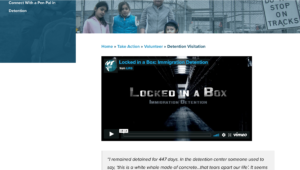
Spatial mode, which is the arrangement of the website. When a person visits LIRS, the home page prompts the reader to scroll down. Although there isn’t an arrow that directly points down, the way that the author designed the layout is that they had a word the was cut off, which forces the viewer to scroll down to see the rest. The home page also prompts the viewer to click on their “read the stories” button, which allows the viewer to get more invested in the website.
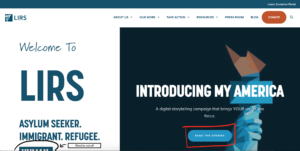 Gestural mode refers to facial expressions, hand gestures, body language, and interaction between people. Just by having the two videos up on their website, it is clear that there is a gestural mode throughout the website. Not only does the website include videos, but there are also plenty of pictures that depict emotion.
Gestural mode refers to facial expressions, hand gestures, body language, and interaction between people. Just by having the two videos up on their website, it is clear that there is a gestural mode throughout the website. Not only does the website include videos, but there are also plenty of pictures that depict emotion.
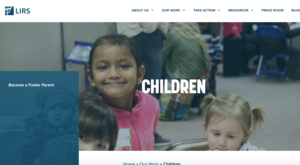
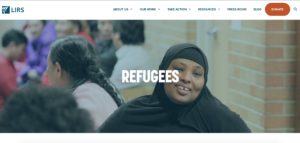

References:
Arola, K. L., Sheppard, J., & Ball, C. E. (2018). Writer/Designer: A guide to making multimodal projects.
Lutheran Immigration and Refugee Service. (2019, February 06). Retrieved February 10, 2019, from https://www.lirs.org/